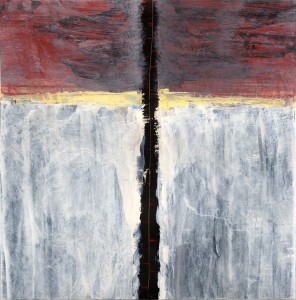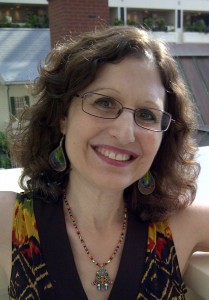Laura Shovan: The title of your poem “The Stick in the Big Boy’s Hand,” acts as a refrain, appearing twice more within the body of the poem. I thought this use of repetition suited the poem’s theme — the places in our memories or personal histories where we become stuck. Why was it important to you to emphasize this particular line?
Jacqueline Jules: Wow! I love the way you phrase that, Laura—“the places in our memories or personal histories where we become stuck.” You articulated my intended theme much better than I would have if you had asked me what the poem was about. For me, “the stick in the big boy’s hand” is a symbol. The majority of my poems have what I call “a controlling image,” an object or concept that represents the emotion I am trying to capture. However, I don’t often use repetition. But in this poem, it felt so right I almost did it unconsciously. As the controlling image, “the stick,” was meant to convey how both sisters were battered by the experience, just in different ways.
LS: Any discussion of childhood sexual abuse is going to be difficult. Explain why you chose, for your speaker, the victim’s older sister. Giving the speaker that little bit of distance deepens the poem, adding a complicated —and lifelong — layer of familial relationships to the narrative.
JJ: I am glad the choice of speaker resonated with you. The decision was highly personal, since this poem was sparked by a comment from a childhood friend who reminded me of an incident involving my younger sister. I observed the abuse from a distance and never fully comprehended how it affected my sister, who suffered psychologically all her life. My goal was to describe my helplessness, my inability as both a child and as an adult, to rescue her.
LS: There’s an almost gentle moment when we see the younger sister, “prone in the dew/ her cheek pressed into the long grass,” before the speaker realizes what’s happening. What does that image symbolize for you?
JJ: This is pure description—what I remember of the incident. I was a child. I didn’t expect to see a violent act and for a moment misunderstood what I saw. Like all poets, I write from my own experiences and emotions. However, I don’t mind changing details if it strengthens my point or theme. And I generally take many liberties in autobiographical poems with a first person narrative. This poem did not require that. Until the last stanza, I described the event exactly as I remembered it.
LS: The poem begins with the nine-year-old older sister who “didn’t know what to do, who to tell, or how to stop/ the stick,” then jumps forward forty years. Talk about how you help the reader make that leap in time.
JJ: That was the biggest challenge of the poem, the part I revised the most. I had to make the reader see the younger sister in bed, years later with “her cheek against the pillow,” recalling the abusive incident. I chose to use dialogue. The younger sister says, “Too dangerous to go outside. The grass is slick.” In this way, I strove not only to refer back to the younger sister’s troubling experience but the older one’s initial misunderstanding of what she saw. And when the older sister says, “I watched from the doorway,” the word, doorway is meant to put the reader clearly inside a house, many years away from the trauma on the grassy hill. It was important in this stanza to show how the sisters were haunted as adults by this childhood experience.

LS: Although it is an abstract piece, Peter Groesbeck’s artwork, “The Path to Pain,” emphasizes the dualities in your poem. How does the painting speak to you, in relation to “The Stick in the Big Boy’s Hand“?
JJ: For me, the black line in the middle of the art is “the stick in the big boy’s hands.” It is also the watershed event in the life of the youngest sister. At the same time, the division of the art represents the different perspectives and impact the incident has for the two sisters. If you start from the white strokes on the bottom and travel to the red at the top, you see a journey from innocence to affliction.
Laura Shovan is editor of the art and literary journal Little Patuxent Review and of two poetry anthologies. Her chapbook, Mountain, Log, Salt and Stone, won the inaugural Harriss Poetry Prize. In 2012, Laura was a finalist for the Rita Dove Poetry Award. She was a 2013 Gettysburg Review Conference for Writers scholarship recipient and has poems forthcoming in Barely South Review, The Fourth River and Switched-on Gutenberg. Laura works with young poets as a Maryland State Arts Council Artist-in-Residence. Visit her online at http://www.laurashovan.com/


Pingback: The Stick in the Big Boy’s Hand | Rkvry Quarterly Literary Journal